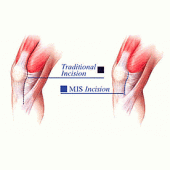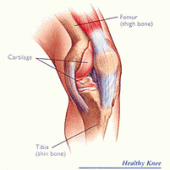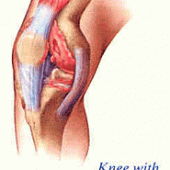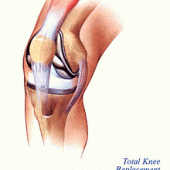Minimally Invasive Total Knee Replacement
Using the Zimmer MISTM Quad-Sparing™ TKA
Traditional knee replacement surgery has been proven to be highly successful at alleviating pain and restoring mobility. However, rehabilitation after traditional surgery can be lengthy and painful. People often postpone knee replacement, not wanting to be away from work and everyday activities for months. Others are concerned about a long surgical scar.
Recently, a new alternative has emerged—the Zimmer Minimally Invasive Solutions (MISTM) Quad-Sparing Total Knee Arthroplasty (TKA), often referred to as a “mini total knee replacement.” This technique uses the same implants as traditional total knee replacement but is less invasive.
The benefits of the Zimmer MIS Quad-Sparing Total Knee include:
- Less trauma to muscles and tendons—the quadriceps tendon and muscles are avoided rather than cut through or manipulated
- Smaller, less disruptive incisions—3 to 5 inches versus 8 to 12 inches
- Shorter total rehabilitation
- Less blood loss
- Less pain
- Shorter hospital stay
As with every surgery, the results of the “mini total knee” depend on the patient’s personal circumstances, including a variety of factors, such as weight, activity level, bone quality, and compliance with the physical therapy program.
The Knee
The knee works as a hinge, joining the femur (thigh bone) to the tibia (shin bone). Cartilage acts as a cushion between the bones, preventing them from grinding directly against one another. Muscles and tendons connect the bones and keep the joint stable. In a healthy knee, all of these factors work together seamlessly.
Arthritis
Osteoarthritis or, less commonly, rheumatoid arthritis can cause the knees to become painful. Rheumatoid arthritis is an autoimmune disorder that causes inflammation of the joints throughout the body. Osteoarthritis can occur after an injury or can be caused by excess body weight, a genetic predisposition, or just normal wear and tear. Over time, the cartilage is damaged and worn away, and eventually, the bones rub directly against one another. This is what causes the pain and permanently damages the knee.
Treatment
There are a number of things that can help, including physical therapy, exercise, losing weight, using a brace or cane, and taking pain-relieving medications. Unfortunately, the improvement is often only temporary. When these options have been exhausted, knee replacement may be the answer.
In a total knee replacement procedure, the damaged areas of the knee joint are removed and replaced with a combination of implants that allow the joint to glide, bear weight, and perform like a natural knee.
This procedure involves resurfacing and replacing the damaged portions of the knee, including the compartments (condyles) at the end of the femur (thigh bone), the top of the tibia (shin bone), and the underside of the knee cap.
Prior to deciding that a total knee replacement is the best treatment option, the orthopedic surgeon performs a thorough physical examination of the patient, including range of motion testing and X-rays, a complete medical history is taken, and all alternatives are discussed with the patient.
There are many factors used to determine whether a patient is a candidate for total knee replacement in general, and the Zimmer MIS Quad-Sparing technique specifically. These can only be evaluated by an orthopedic surgeon after the patient undergoes the examination and testing mentioned above.
The Zimmer MIS Quad-Sparing TKA
Preoperatively, the patient may need to donate one or two units of blood. Although the “mini total knee” procedure generally results in less blood loss compared to traditional knee replacement, transfusions may still be needed during surgery. The patient must also be cleared by his or her regular physician or internist.
The surgery is performed under either a general anesthesia or a regional epidural, which numbs the lower half of the patient’s body. Special guides and instruments allow the procedure to be done utilizing the smaller incision discussed earlier. The damaged surfaces of the knee are removed and the ends of the bones are reshaped to allow for placement of the implants. The implants are secured to the bones and, if necessary, the surgeon adjusts the ligaments that surround the knee to allow for unimpaired knee function. Once the surgeon has completed this procedure, the incision is closed.
The surgery usually takes between one and three hours. A drain is inserted into the wound to reduce the fluids that accumulate at the surgical site, then the incision is covered by a sterile bandage.
Post-operatively, the knee will remain swollen and tender for a few days. A rehabilitation program is begun in the hospital, as soon as possible following the surgery. About four to six hours after surgery, the patient is helped to stand; within the first 24 hours, the patient begins walking, usually using a walker. As soon as the physical therapist has cleared the patient to ambulate and actively extend the knee, the patient is discharged. This usually occurs within 24 to 48 hours from the time of surgery. A home exercise program and physical therapy will then be prescribed. Follow-up visits with the surgeon are scheduled within the first one to two weeks after the surgery.
Within weeks of the surgery, most patients are able to walk with a cane or with no support at all. Some patients are even able to resume most normal activities (other than driving) within seven to ten days after surgery. Of course, these recovery times vary with each individual.
The goal of a successful total knee replacement is to relieve pain and stiffness and allow a return to normal daily activities. However, of course, there are still some restrictions—contact sports or activities that put excessive strain on the knee are not allowed. The surgeon and his staff give clear guidelines to each patient, and following these are in the patient’s best interest. Revisions of the total knee procedure can be done down the road, but usually, a second surgery of this type is not as effective as the first.
For further information about the Zimmer MIS Quad-Sparing TKA, please call Dr. Friedman’s office at (818) 901-6600, ext. 2610.





